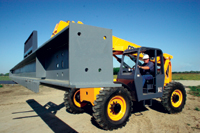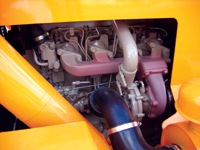No Heavy Lifting
 You can’t turn a corner without hearing talk of the labor shortage in construction, particularly when it comes to mechanics. With such a small pool of talent available, telehandler repair is becoming more costly and time consuming. That’s why it’s so important to stay on top of your machine’s overall health and well-being.
You can’t turn a corner without hearing talk of the labor shortage in construction, particularly when it comes to mechanics. With such a small pool of talent available, telehandler repair is becoming more costly and time consuming. That’s why it’s so important to stay on top of your machine’s overall health and well-being.
It’s the oldest lesson in construction equipment — invest time and money in preventive maintenance and you’ll save in the end. And it’s truer now than ever when you consider the cost to address telehandler damage. That’s because it’s the rare telehandler part that simply needs repair. Most of the time, damaged telehandlers require parts replacement, costing owners both cash and downtime.
Take the problem of leaking hub seals, for example. Hub seals are located on the planetary wheel drive, and their purpose is to keep lubricants clean for the final drives. There’s no repairing these seals once they’ve begun to leak, and the cost to replace them can run up to $230 per wheel. Maintenance of the drives, which involves changing the hub lubricant every 500 hours at a cost of less than $50 per wheel, can save owners from the downtime and enable close inspection of the seals.
Now let’s say the telehandler owner doesn’t maintain a good lubricant-changing schedule and the seals begin to leak. The only way he’s going to be aware of the problem is by paying attention to his machine so as to see the leaking fluid upon the inspection process.
The daily walk-around is a basic tenant of every responsible equipment maintenance program. It’s typical for an operator or even an entire crew to become comfortable with a machine — particularly when the machine is performing well. But when it comes to preventative maintenance, comfort can be dangerous because it leads to neglect.
Whether it’s a mechanic or an operator, a responsible party should be in charge of checking fluid levels and tire wear and watching out for red flags, such as missing bolts and leaking fluid. This will help keep maintenance and repair costs down tremendously.
For instance, if the damaged hub seal goes undetected and the telehandler operator continues as usual, he may damage the unit’s entire planetary assembly, which could cost up to $2,300 to repair.
Keeping clean fuel and filters in the telehandler are inexpensive methods for preserving the quality and performance of the machine. At a cost of around $20, changing fuel filters frequently (every 150 hours) will avoid the cost of the alternative — excessive engine wear or the need for an entirely new engine.
And while keeping clean fuel in the machine is important, keeping fuel itself in the machine is vital. Sounds simple, doesn’t it? But you would be surprised at how many times a new operator will attempt to start a machine with an empty fuel tank. What’s the cost to replace the starter on a telehandler? More than $500. It’s much less expensive to train operators on even the simplest of solutions, such as keeping the telehandler’s fuel tank full.
Replacing a telehandler engine could cost more than $10,000. The money required by a good preventive maintenance program pales in comparison to the alternative.

Like hub seals, cylinder rods are not repairable; they must be replaced. While it’s unlikely to need to replace an entire cylinder, the rod replacement parts and labor are costly enough. Costing up to $650 per tilt-cylinder rod, repairing the damage from a bump into an existing structure is an expensive procedure.
Preventive maintenance can be a difficult challenge, especially for crews without their own mechanic. These days, skilled technicians are earning $20 or more per hour, putting an in-house repairman out of reach for many telehandler owners. That’s why so many dealerships and rental houses are offering high-quality, affordable service to their customers. Companies like NCS Equipment have hired skilled, factory-trained technicians with the experience and the know-how to keep equipment running at its peak potential. When you compare the repair and downtime costs of a broken unit to that of a maintenance program, it’s easy to see that prevention makes the most sense. And with the dedicated maintenance personnel and after-sales support dealerships and rental houses working hard, equipment owners really don’t have any excuses for neglecting their machines.
Joe Parriott is a regional sales manager for Mustang Mfg., based in Omaha, Neb.

Comments are closed here.